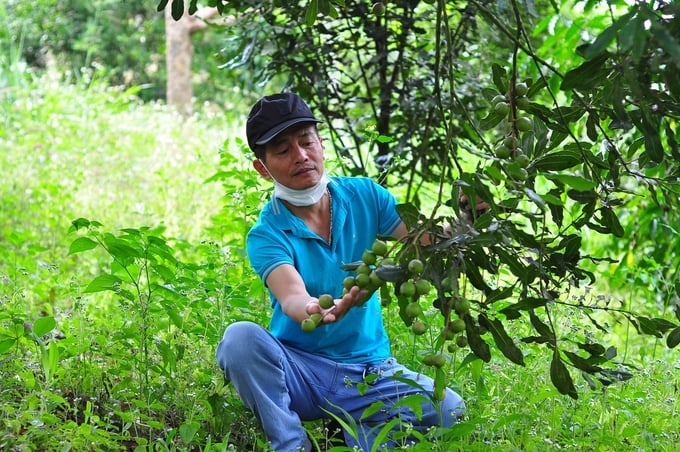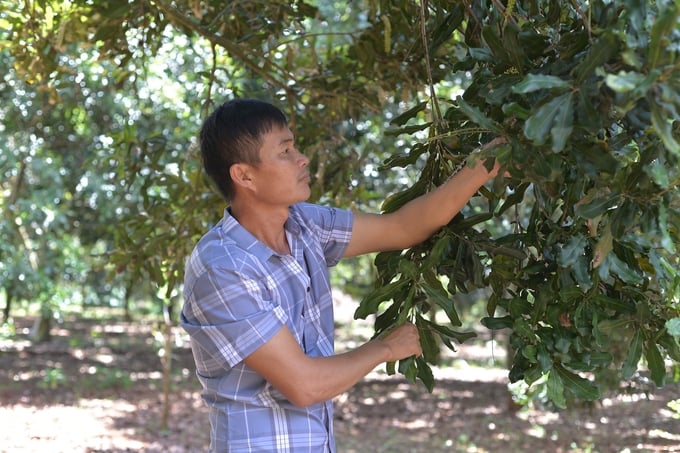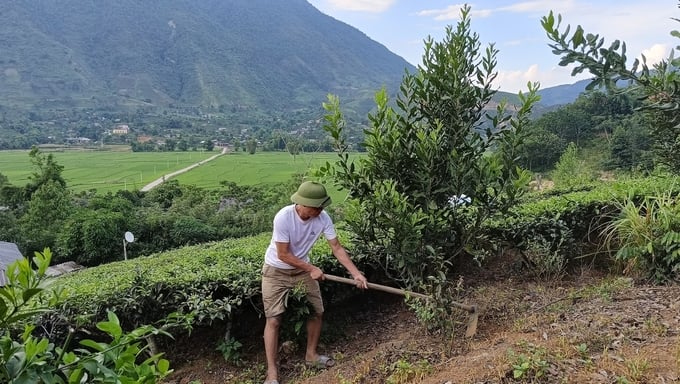November 27, 2025 | 09:26 GMT +7
November 27, 2025 | 09:26 GMT +7
Hotline: 0913.378.918
November 27, 2025 | 09:26 GMT +7
Hotline: 0913.378.918

Trieu Van Luc, Deputy Director of the Department of Forestry. Photo: Trung Quan.
Vietnam has great potential in terms of land and climate suitable for the growth and development of macadamia trees. The potential area for developing macadamia in the North West and Central Highlands is about 453,000 ha. In addition, some other provinces, such as Lang Son, Yen Bai, Thanh Hoa, and Quang Tri... also have ecological sub-regions suitable for growing this plant.
Over the years, the research, selection, and production of macadamia varieties have been increasingly developed. Up to now, 13 high-yield and high-quality varieties have been recognized for ecological regions. Seed production capacity continues to be improved, annually producing about 2 million grafted plants, meeting the needs of local farmers.
Deputy Director of the Department of Forestry Trieu Van Luc said that, technically, macadamia trees have a long harvest time of 50-60 years, are less susceptible to pests and diseases, and use less labor and water than some other plants. The average net yield is about 3 tons of fresh seeds/ha. The intercropping yield is 1.5-2 tons of fresh seeds/ha. The selling price ranges from VND 70,000 to VND 100,000/kg of fresh seeds.
Another advantage of developing macadamia trees in Vietnam is the abundant labor source. The labor cost is cheaper than in many countries in the world, and the organization of production of the macadamia in the chain has been formed. In particular, the established Vietnam Macadamia Association has become a close connection between households and businesses in developing macadamia production.

Many places in the Central Highlands have suitable ecological conditions, good seed and investment, and high economic efficiency. Photo: Kien Trung.
In the past, some localities still have the situation of spontaneously developing macadamia production between businesses and people. Therefore, according to Tran Van Luc, to organize effective and sustainable production of macadamia nuts, companies, and people need to note that macadamia trees have strict climate requirements, especially when they come out with flowers and fruit. Therefore, it is only planted in places that are assessed to be suitable for macadamia trees and have a deployment model that is evaluated as effective.
Joint venture contracts must clearly define responsibilities and authorities between the parties and must be confirmed by local authorities, preferably enterprises associated with cooperative groups or cooperatives. The agreement must be explicit on the supply of seedlings, fertilizer materials, labor, land, harvesting, processing, market, price, and benefit rate.
Deputy Director of the Department of Trieu Van Luc Forestry said that for the development strategy of macadamia to be truly sustainable, it is necessary to comply with the implementation of 6 solutions as follows:
- Regarding science and technology: it is necessary to continue researching, selecting, importing, and testing to diversify the macadamia varieties in the direction of high productivity, quality, and economic efficiency, resistance to pests and diseases, and adaptation to different ecological sub-region.

Macadamia trees have strict climate requirements, especially when flowering and fruiting, so not everywhere can be suitable for growing macadamia. Photo: Hoang Anh.
- Regarding the organization of production: the localities based on practical conditions shall coordinate with scientific units in reviewing the land fund under the planning of production forests to develop macadamia under the method of pure-species planting; intercropping macadamia on land for industrial crops and bare land under the planning of protection forests, following the provincial planning and the land use plan in each period.
- Regarding the consumption market: branding of macadamia products associated with geographical indications and carrying out trade promotion, propaganda, and introduction activities to give domestic consumers enough information. Information about macadamia products. Implement measures to expand export markets and remove trade barriers. To focus on implementing measures to promote the official export of whole-shelled macadamia nuts and kernels and deeply processed macadamia products to the demands of other countries.
- Regarding mechanisms and policies, it is necessary to organize and implement the tools and guidelines issued to develop macadamia, such as the sustainable Forestry Development Program for the period of 2021-2025, The National Target Program for Socio-Economic Development in ethnic Minority and mountainous areas in the 2021 - 2030 period; continue to review, supplement, and issue new mechanisms and policies.

The macadamia tree is promising and marketable. However, farmers should not spontaneously grow macadamia without appropriate ecological assessment and no basis for affirming its effectiveness. Photo: Kien Trung.
- Regarding investment capital, it is necessary to diversify sources of investment capital for the sustainable development of Macadamia in the direction of socialization, mainly capital of businesses, people, and other legal capital sources. Focus on investing in building material areas and facilities for preliminary processing, processing, and consuming macadamia products.
- Regarding international cooperation: continue to expand cooperation with other countries and international organizations to remove trade barriers, expand the consumption market of macadamia products, and strengthen cooperation in science and technology transfer in the field of science and technology, the process of cultivating, harvesting, preserving and processing macadamia products.
The total export turnover of Vietnam's macadamia in 2016-2020 reached nearly US$60 million, with over 3,000 tons of kernels and 390 tons of whole macadamia nuts. Vietnam's macadamia nuts have been exported to 21 countries and territories worldwide. In addition, compared with many major macadamia nut exporting countries, Vietnam has the advantage of participating in free trade agreements with the most significant global import markets.
Translated by Ha Phuc
/2025/11/26/4909-2-154329_878.jpg)
(VAN) Pearl grouper farming in HDPE cages not only delivers economic efficiency but also contributes to protecting the environment, creating jobs, and promoting marine-based experiential tourism.

(VAN) The model of making a living under the forest canopy through the agroforestry system in Van Son commune, Bac Ninh province, is expected to generate an annual income of approximately VND 30 million/ha.

(VAN) Many enterprises in Can Tho are harnessing natural energy and reducing greenhouse gas emissions in their production processes, thereby contributing to the promotion of a sustainable green transition.
/2025/11/24/3536-2-112800_176.jpg)
(VAN) Dong Nai now has tens of thousands of hectares of forests certified for sustainable management, and this area will continue to be expanded in the coming period.

(VAN) Vinh Ha hamlet (Dai Xuyen commune, Hanoi) is shifting away from small-scale farming as households adopt bioscurity into their breeder chicken models.

(VAN) Heavy rains make aquatic species more vulnerable to disease. Proactive water management and high-tech systems help farmers prevent outbreaks and protect yields.

(VAN) Greenhouses are shifting production mindsets in Binh Lu commune, enabling farmers to ‘weather the sun and rain’ and secure stable vegetable harvests throughout the year.